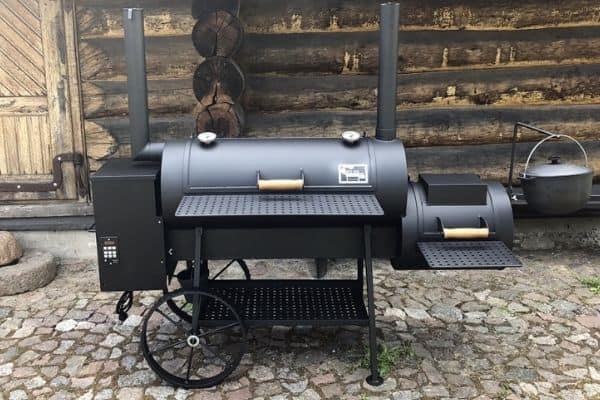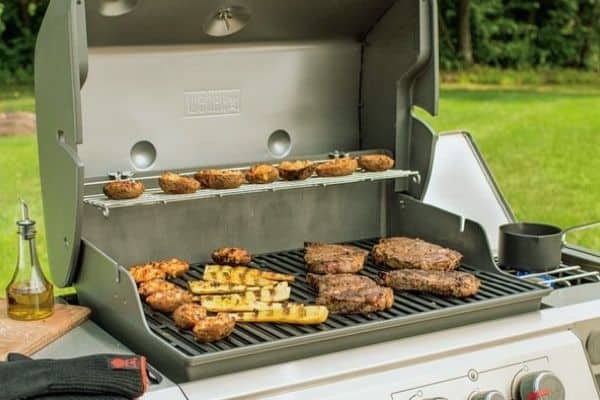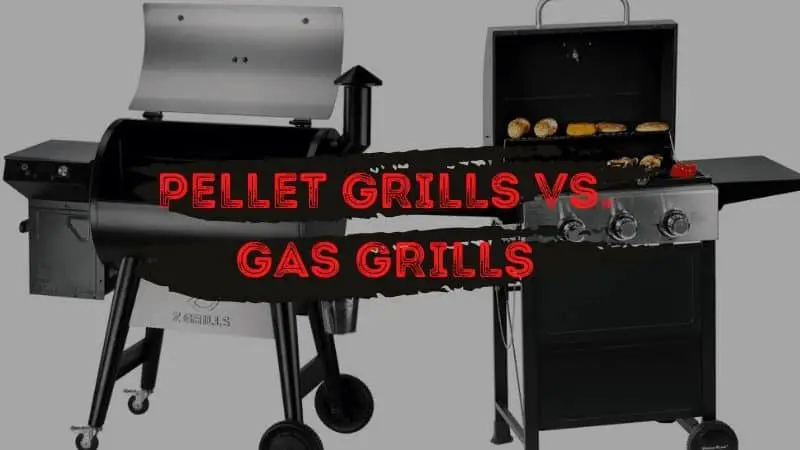Pellet grills and gas grills have different pros and cons. A pellet grill is a more environmentally friendly option as it burns wood pellets instead of natural gas or propane. They also give off less smoke, making them ideal for people with sensitive allergies, asthma, or other respiratory conditions. Gas grills are easy to operate because they start up automatically after you turn the knob to ignite the flame. You can cook your favorite foods on both kinds of grills if you know how to use them properly!
To find out which one is best for your needs, read on! This blog post will compare these two types of grilling options so that you can make an informed decision when buying your next grill.
What Is A Pellet Grill?
A pellet grill, also known as a pellet smoker, is an outdoor cooking appliance that combines the features of gas grills and charcoal smokers with the use of wood pellets.

Pellets are made from hardwood sawdust or compressed pieces of bark, which are then liquefied to produce fuel for the grill.
Because it does not have direct exposure to flames like traditional grilling appliances, pellet grills can achieve accurate temperatures without any risk of catching fire.
This makes them safer than gas grills and good for searing meats over high heat while retaining juices inside.
Advantage Of Pellet Grills
Some advantages of pellet grills are that they use a heat-pump system to heat pellets, create less smoke than normal grills, and have a special feature called “Pellet Boss” which allows you to control how many pellets you want the grill to use.
Pellet grills also come with a variety of options, such as an attached meat probe or digital temperature control. They can be built-in or out of your home, depending on the size it needs to be, and comes with either stainless steel or cast iron doors for extra durability.
Not only do these pellet grills look amazing, but they provide high quality food for your family and friends!
Disadvantage Of Pellet Grills
Pellet smokers are often more expensive than charcoal or gas grills, and they require power.
The price of pellets can be a big upfront investment for some people who want to buy their own smoker without looking into all the other costs involved with maintaining one too!
What is A Gas Grill?
A gas grill, also known as a gas barbecue or simply BBQ cooks food with prop or natural gas as the heat source, with or without flavor being added by wood smoke.

Gas grills are convenient because they start with the push of a button and do not require tending.
Advantage Of Gas Grills
One advantage of a gas grill is that you can choose from a wider variety of grills. There are three types of grills: propane, natural gas, and charcoal. While a pellet grill may not offer all three options!
Another advantage is that they are easy to assemble and can last for years without having to be replaced. Gas grills tend to be less complicated than pellet grills because there aren’t any bells or whistles.
They just provide the essentials for cooking with fire, which some people prefer instead of the high-tech gadgets included in pellet grills.
Gas grills also come in more sizes, so you can fit them in your outdoor kitchen more easily. Because of this, some people prefer the larger sizes that gas grills come in for big parties or family gatherings.
Disdvantage Of Gas Grills
A gas grill is a great way to cook food, but there are some major disadvantages.
For example:
Gas leaks can cause an explosion which would mean injury or death for those nearby.
Flavor may not be experienced due too its reliance on fuel combustion instead of firewood like with charcoal grills; this means that you won’t enjoy smoking your meat at low speeds and slow pacing.
It also cannot produce smoky flavors (as seen in traditional barbecues).
Pellet Grills vs. Gas Grills Comparison
Easy To Use
With gas grills, you have to wait until the temperature is just right before you can put food on it. With pellet grills, all you need to do is load the hopper with pellets and get started! You can then adjust your cooking time through different vents without having to worry about being impatient while waiting for your grill to get hot enough.
Temperature Control
If you are looking for an easy way to regulate how much heat is escaping from your grill, then pellet grills are definitely worth considering. The more heat escape in a gas grill, the longer it will take for your meat to be cooked through and end up juicy and tender. Pellet grills offer many options when it comes to their heat output which will give your food the best chance of being cooked to perfection.
Temperature Range
The temperature range is not too far off for either of these types of grills. Gas grills can reach temperatures between 150°F to 650°F while pellet grills can reach temperatures between 180°F to 500°F. The bigger difference is that gas grills get hot enough to sear meat, but it’s hard to get the perfect golden brown color with one because it takes a long time to cool down after each use. Pellet smokers are able to hit temperatures high enough for searing or low enough for cooking in order to make sure your food gets the ideal grill marks on top.
Cooking Grids
A lot of people wonder whether the racks are interchangeable when it to different types of grills. Pellet grills typically use a reverse flow configuration in order to ensure the best chance of getting all your food cooked properly and safely. The grids can be adjusted so you can separate certain foods from each other based on their cooking time and needed heat level. Gas grills usually come with porcelain-coated cast iron or stainless steel racks for durability and easier cleanup.
Ease Of Cleaning
Both gas grills and pellet grills require regular upkeep in terms of cleanliness, but they both offer different levels of difficulty when it comes to keeping them that way. If you want something that is easy to clean then a pellet grill is perfect because there are not many grooves where grease can get stuck like there is on a gas grill. Gas grills provide an excellent cooking surface, but it is easy to get burned when trying to clean up because of the way they are designed.
Cooking Grate Distance From Flame/Heat
A common mistake that people make with pellet grills is not allowing enough space between the cooking grate and the heat source. This can cause your food to cook too slowly or burn due to being exposed to the flame for too long. With a gas grill, you have no worries about accidentally placing your food in this position because you don’t have a direct source of flame underneath that you cannot control. This does not mean that gas grills will never cause this problem though if they are not properly adjusted before use.
Versatility
Pellet grills are often seen as being more versatile because they have a few different cooking options available. You can choose to use just the pellet smoker function or combine it with the grill feature so you can get an even cook on your meat. Gas grills usually only come as a complete package, which means they might not be as versatile as some people would like them to be. This does not mean that gas cannot excel at any style of cooking though, it just takes a little more knowledge and know-how to do so!
More Flavorful Food
Since pellet grills are not exposed to open flames, this means that they won’t emit any type of smokey flavors into your food. This not only results in more flavorful food but also healthier meals for you and your family! No matter what recipe or dish you are preparing, it is sure to be juicy and delicious thanks to the superior taste of grill cooking! These wonderful features mean you’ll never need another gas grill again after switching over.
The most distinguishing feature between pellet grills vs gas grills is their automated temperature control system. Pellets ignite once introduced into the fire chamber, gas requires an outside ignition source. Gas grills are generally easier to use, but pellet grills offer more precise temperature control. Either choice is sure to result in mouthwatering recipes!
Price
The average price range for a standard pellet grill is about $500 – $700 compared to around $200-$400 for a gas grill unit. This is primarily due to the fact that it takes more time and materials to build a quality pellet grill. In addition, you also have to purchase pellets in order to use them because they do not provide their own source of fuel.
Conclusion: Which One Should You Buy?
The fact is that there are advantages to both types of grills, but which one you buy will depend on your personal preferences.
Gas grills are very convenient. They require no pre-heating time, are easily adjustable for heat control, and can grill food relatively quickly. Gas grills are also easy to find fuel for – all you need is a regular propane tank or natural gas line hooked up to the grill itself. This makes them great for anyone who might not have an outdoor space to store large amounts of charcoal at any given time, or does not want the hassle of having live coals for cooking. However, they often take up more space than other options, and can sometimes emit strong odors into the surrounding area.
Pellet grills, on the other hand, use a traditional “pellet” as their fuel source, which is made from compressed sawdust and burns very efficiently. They also require no lighter fluid – simply adjust the setting to preheat the grill and wait for the pellets to ignite – but they do take longer than propane or natural gas to actually reach cooking temperature (usually about 15 minutes). Because they are not dependent on an open flame like traditional grills, however, many believe that pellet grills produce less smoke than gas grills, making them “greener”. Some models come with built-in fans that automatically speed up the preheating process you’ve closed the lid, which speeds up the preheating process and thus reduces cooking time.
Thanks for reading! Don’t forget to comment if you have any questions about pellet grills vs. gas grills, and subscribe if you want to get notified whenever we post another article!
